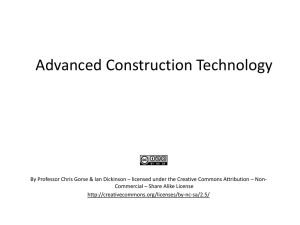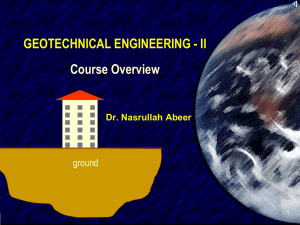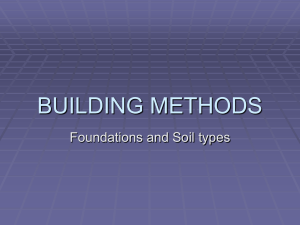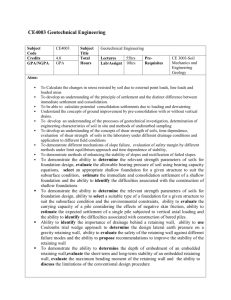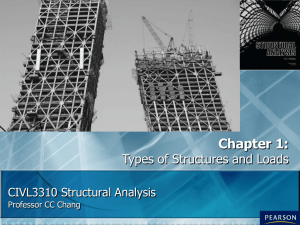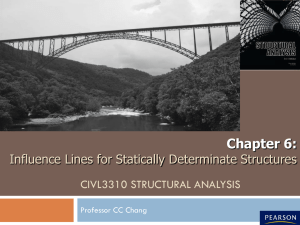Minimum width of strip foundations
advertisement
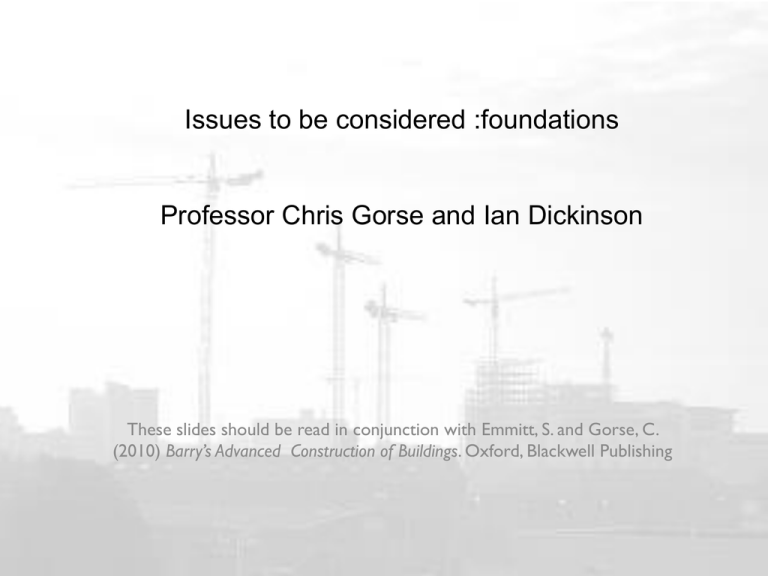
Issues to be considered :foundations Professor Chris Gorse and Ian Dickinson These slides should be read in conjunction with Emmitt, S. and Gorse, C. (2010) Barry’s Advanced Construction of Buildings. Oxford, Blackwell Publishing Advanced Construction Technology By Professor Chris Gorse & Ian Dickinson – licensed under the Creative Commons Attribution – Non-Commercial – Share Alike License http://creativecommons.org/licenses/by-nc-sa/2.5/ Position of loads on foundations • Loads should be positions centrally on foundations ensuring that loads are distributed evenly across the whole foundation area Walls should be positioned centrally on the strip foundation Loads should be evenly distributed to avoid uneven or differential settlement Uneven distribution of loads may cause the foundation to crack If the foundation exerts different loads on the ground under the wall, the foundation will settle into the ground to different extents and the foundation and wall may crack. Causes of differential settlement If one part of the building is loaded more than another (e.g. heavy equipment) and the foundations do not allow for this settlement may occur in this area as the ground is overstress Buildings or loads in close proximity Load bearing strata Where foundations are close together the stress exerted on the soil can overlap increasing the force such that the ground fails and settlement occurs Weak strata Where one part of the build sits on firm ground and another part rests on weak or unstable strata the building is likely to suffer differential settlement. Excessive settlement may fracture services Differential settlement due to different foundation systems If different foundations systems are used within the same building, the buildings may need to be separated to prevent cracking. Where different foundation systems are used buildings will move and settle differently. Where multiple foundation systems are used buildings should be treated as separate buildings and have movement joints. Strip foundation and foundation design • The following chart provides an extract from the Building Regulations. • Look at the different types of soil. • Stronger soils can take higher loads (rock, sand, gravel and stiff clay). • Where soils are weaker (sandy soft clays) the width of the foundation has to be increased. Allowable bearing pressure of soil and ground Bearing capacity (kN/m2) Soil and ground classification Rocks Strong sandstone Schists Strong shale Granular soils Dense sand and gravel Medium dense gravel Loose sand and gravel Compact sand Loose sand Cohesive soils Stiff boulder clay Stiff clay Firm clay Soft clay and silt 4000 3000 2000 > 600 200 – 600 < 200 > 300 < 100 300 – 600 150 – 300 75 – 150 < 75 Adapted from BS 8004;1986 Avoiding shear failure Strip foundation P should be less than depth T to avoid shear P Load distribution angle 45o T Forces outside the compressive zone • As the compressive force can only be contained within a 45 degree angle, un-reinforced foundations that are wider than that accommodated within the compressive zones will suffer shear failure. • If the width of the foundation is too wide and not sufficiently deep tensile forces will be exerted on the foundation. Concrete is poor in tension and will crack. Shear failure Strip foundation The foundation fails where tension is exerted on the concrete P If P is greater than T then the foundation may shear at 45o reducing the width of the foundation and bearing area. T Shear failure angle 45o Following the shear failure the load is concentrated on a smaller area, the ground may consolidate under the increased load. Strip foundation – deep formation level Built up with trench blocks Built up with concrete Area above main foundation filled with concrete Area above main foundation filled with trench blocks Use of trench blocks below ground Trench blocks used to build up to ground level Foundation depths To avoid frost heave foundations should be constructed at least 450mm below the surface. The depth of the foundation will depend on the type of soil, distance from the tree and water demand of the tree. Water demand is dependant on the height and type of tree. E.g. for a 20m high Oak tree in high shrinkage soil, 10m from the face of the foundation, the foundation should be at least 2.50m deep Min. 450 mm Shrinkable soils (Clay) Min. 750 should be at least 750mm mm deep for clays with a low potential shrinkage and 1m where there is high potential shrinkage. High shrinkage soils close to mature tree 1m – 3.43m deep Precautions against heave Backfill Where the ground is susceptible to heave precautions should be taken. Voids should be left below floor slabs and compressible material should provide a barrier between the soil and foundations Compressible material or void former to the inside face and underside of the ground beam, this prevents the beam lifting or moving when the clay expands Void 125 –300mm Slip liner can be used around pile Precaution against heave Where the ground is susceptible to heave precautions should be taken. Void 125 –300mm Backfill Voids should be left below floor slabs and compressible material should provide a barrier between the soil and foundations Where trench fill is greater than 1.5m deep a compressible material or void former should be used against the inside face of the foundation, positioned in accordance with manufactures instructions Prevents the foundation being pushed outwards 500mm Backfill
